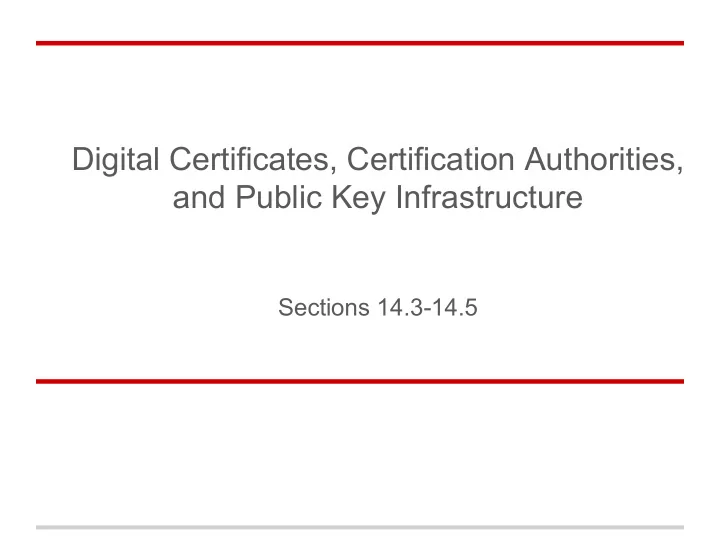

Digital Certificates, Certification Authorities, and Public Key Infrastructure Sections 14.3-14.5
Basic Problem • What does a public-key signature verification tell you? Verification parameters include public key, and successful verification says “ Only someone holding the corresponding private key could have made this signature .” • What do you want a signature verification to tell you? Probably something like “ Joe Smith signed this .” • Problem: What assurance do you have that the public key really belongs to Joe Smith?
What is a Digital Certificate? • Associates an identity/properties with a public key – Identity can be person’s name, website, e-mail, ... – Properties can be valid key uses, age of individual, access rights granted, … • Signed by someone you trust – Signature is trusted party vouching for ID/key pair – Role is similar to a notary public • Some typical properties of certificates: – Good for a set time (validity period) • Must get a new certificate after expiration – Certificates may be revoked
More on Certificates • Common types of certificates: – X.509 standard (version 3) – PGP certificates • Who signs certificates? Several possibilities: – Independent “Certification Authority” organization • Disinterested third party – company or government • Examples: Verisign, Deutsche Telekom, Entrust, AOL, … – Internal (organizational) certification authority • Organization controls certificates for employees or clients – Could be just an individual you trust • This is how PGP certificates are typically certified
X.509 Certificates • Most prevalent type of digital certificate • Related to X.500 directory services • An integral part of the Web – All major web browsers and servers support X.509 – CA “industry” (Verisign, etc.) built around X.509 • Also part of secure e-mail specifications – S/MIME • Currently “version 3” of X.509 – Includes a flexible “extension field” capability
X.500 Names (Also called “Distinguished Names”) • Hierarchical naming • Parts of names are attribute/value pairs • Example attributes: – C=country – ST=state – L=locality – O=organization – OU=organizational unit – CN=common name
Important “Additional Information” • How does a CA state how they do business? – A Certification Practices Statement (CPS) is a human-readable statement of practices used by CA • Based on this, a person/vendor may decide whether to trust or not trust the CA • Problem: What if CPS becomes a dead link? Trust the CA? • Where to obtain the Certification Revocation List (CRL) – Called a CRL Distribution Point (CDP) – Certificates may be revoked due to • Private key compromised • Incorrectly issued certificate • CA compromised • Properties change – CRL contains unexpired revoked certificates • Current (2018) size of Symantec CRL: 1,211,730 bytes (34,610 entries) – Newer technology: OCSP (Online Certificate Status Protocol)
Example: Amazon Certificate (Extension fields removed) Data: Version: 3 (0x2) Serial Number: 79:df:6e:64:52:f0:6a:12:05:ac:c8:80:7b:0a:d5:8e Signature Algorithm: sha256WithRSAEncryption Issuer: C=US, O=Symantec Corporation, OU=Symantec Trust Network, CN=Symantec Class 3 Secure Server CA - G4 Validity Not Before: Oct 6 00:00:00 2017 GMT Not After : Sep 21 23:59:59 2018 GMT Subject: C=US, ST=Washington, L=Seattle, O=Amazon.com, Inc., CN=www.amazon.com Subject Public Key Info: Public Key Algorithm: rsaEncryption Public-Key: (2048 bit) Modulus: 00:de:59:92:15:5c:f4:ae:8e:c4:ee:8e:ff:b3:97: ... [ Deleted ] ... Exponent: 65537 (0x10001) ... Signature Algorithm: sha256WithRSAEncryption 1f:01:57:8d:2f:fe:26:bb:5d:43:59:5a:86:42:47:47:2f:5e:
Example: Amazon Certificate, Part 2 Extension fields X509v3 extensions: X509v3 Subject Alternative Name: DNS:amazon.com, DNS:amzn.com, DNS:buybox.amazon.com, [ ... ] X509v3 Basic Constraints: CA:FALSE X509v3 Key Usage: critical Digital Signature, Key Encipherment X509v3 Extended Key Usage: TLS Web Server Authentication, TLS Web Client Authentication X509v3 Certificate Policies: Policy: 2.23.140.1.2.2 CPS: https://d.symcb.com/cps User Notice: Explicit Text: https://d.symcb.com/rpa X509v3 Authority Key Identifier: keyid:5F:60:CF:61:90:55:DF:84:43:14:8A:60:2A:B2:F5:7A:F4:43:18:EF X509v3 CRL Distribution Points: Full Name: URI:http://ss.symcb.com/ss.crl Authority Information Access: OCSP - URI:http://ss.symcd.com CA Issuers - URI:http://ss.symcb.com/ss.crt
Certificate Chains (Hypothetical) “Trust Anchor” or “Root CA” Subject: Verisign Verisign Public Key Subject: UNCG CS CA Issuer: Verisign (trusted) UNCG CS Public Key Issuer: UNCG CA Signs Signs Signs Subject: UNCG CA Subject: Steve Tate UNCG Public Key Steve’s Public Key Issuer: Verisign Issuer: UNCG CS CA
Public Key Infrastructure (PKI) • A PKI is “a collection of technologies and policies for creating and using digital certificates.” [Garfinkel and Spafford] • Many people originally envisioned an official digital ID system – In reality: Very little personal ID done with certificates – mostly used for server identification – Could change if security tokens or smart cards become more prevalent! Maybe smartphones?
Another Trust Model: PGP “Web of Trust” • PGP is “Pretty Good Privacy” – Originally for e-mail encryption/signing ■ Now regularly used for software verification – Originally written by Phil Zimmerman – Now several free and commercial versions – GPG (“Gnu Privacy Guard”) is a Free-Software alternative (they use only free algorithms) • Trust model is less hierarchical than X.509 • I can sign keys and distribute them – Anyone who trusts me can use me as a CA! – Difference between “trusted” and “valid” keys
PGP/GPG Keyservers • Problem: How do you get public keys? – Note: In PGP public keys are always certificates • Solution: Keyservers – databases of keys – You can submit your own keys – You can look up keys by name or e-mail address – Support integrated into many e-mail programs • Keyservers can be accessed in many ways – LDAP – HTTP – E-mail
Keyserver example – WWW interface Sending an encrypted email – Step 1: Look up the key
Keyserver example – WWW interface Sending an encrypted email – Step 2: Find the right one - who vouches for it?
Keyserver example – WWW interface Sending an encrypted email – Step 3: Download key (to import into PGP)
Some problems with certificates • Private keys are not people • Distinguished names are not people • There are too many Robert Smiths • X.509 v3 doesn’t allow selective disclosure • Ubiquitous certificates could lead to privacy issues • How do you loan a key? • Signatures are “brittle” • But overall: Not perfect, but solves some important problems
Recommend
More recommend